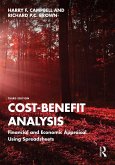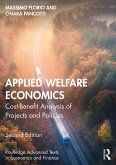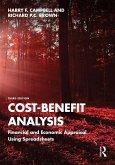This timely sixth edition of the classic Cost-Benefit Analysis text continues to build on the successful approach of previous editions, with lucid explanation of key ideas, simple but effective expository short chapters and an appendix on various useful statistical and mathematical concepts and derivatives. The book examines important developments in the discipline, with relevant examples and illustrations as well as new and expanded chapters which build upon standard materials on CBA. Highlights include:
- updated historical background of CBA
- extended non-market goods valuation methods
- the impact of uncertainty
- evaluation of programmes and services
- behavioural economics
- decision rules and heuristics
- CBA and regulatory reforms
- CBA in developed and developing countries
- value of household production
- other topics frequently encountered in CBA, such as costs of diseases and air pollution, and value of statistical life.
This book is a valuable source and guide to international funding agencies, governments, interested professional economists and senior undergraduate and graduate students.
The text is fully supported by a companion website, which includes discussion questions and PowerPoint slides for each chapter.
Dieser Download kann aus rechtlichen Gründen nur mit Rechnungsadresse in A, B, BG, CY, CZ, D, DK, EW, E, FIN, F, GR, HR, H, IRL, I, LT, L, LR, M, NL, PL, P, R, S, SLO, SK ausgeliefert werden.
'In this 6th edition of his classic treatise, Cost-Benefit Analysis, Professor Euston Quah provides an up-to-date rendering of the fundamental concepts that constitute the foundation of this important analytical tool, as well as the essential empirical methods, ranging from the basics of discounting to the latest methods of valuing externalities. This book can function as a comprehensive text in an appropriate college course, and as a key reference for practitioners. As such, it belongs on the shelf of scholars, policy analysts, and policy makers'. - Professor Robert N. Stavins, A. J. Meyer Professor of Energy and Economic Development at Harvard University, USA.
'Building on the earlier eminent work with E.J. Mishan, the sixth newly updated edition of Euston Quah's continues to improve what has been referred to as a classic work in Cost Benefit analysis. It is a very important book for both practitioners and academics. I strongly recommend it as a reference book for all of us interested in public policy'. - Richard L. Sandor, Aaron Director Lecturer at Ronald Coase and Richard Sandor Institute of Law and Economics of the University of Chicago, USA.
'This timely 6th edition builds on the success of previous editions. The key economic tools are lucidly explained and the new themes explored. The case studies are up-to-date and cover a wide range of potential applications. It will be an indispensable source and guide to government and international agencies as well as to students and professional economists'. - Professor Cheng Hsiao, Former Editor of the Journal of Econometrics and Professor of Economics at University of Southern California, USA.
'Increasingly, calculations of gains and losses if made for communities and societies have to take into account a contextualized and scale-sensitive economic order. This 6th updated edition offers an excellent guide by integrating investment criteria, uncertainty and frequently encountered issues in the actual use of CBA while examining the continued validity of key concepts, the limitations of the criteria used and the consistency of techniques. It is highly recommended to everyone making informed decisions when resources are scarce'. - Professor Helga Nowotny, Former President of the European Research Council.
As a text, Mishan and Quah's Cost-Benefit Analysis shows the intuition of how to use economics as it instructs how to do CBA. As a reference, from the first edition it has been within easy reach of my desk'. - Professor Jack L. Knetsch, Emeritus Professor of Economics at Simon Fraser University, Canada.
'Cost-Benefit analysis is the most well known word in economics. However, it is not deeply understood what and how to measure and what kind of conditions the analysis be applied. The analysis can be used in many different projects not only to public and private projects but also to our daily lives. Economists often discuss the cost-benefits, however engineers and medical doctors have to pay attention to cost-benefit analysis results. Otherwise, various policies which may incur huge costs would be proposed and cost of burden to the general public may be very high in the future. This book explains very simply the essence of cost-benefit analysis and its applications in many different areas. The book is recommended not only to students in economics and business, but also to a general audience who wish to understand public decision-making. This book will help you think and make better decisions in your daily life'. - Professor Naoyuki Yoshino, Dean/CEO of Asian Development Bank Institute, Japan, and Professor Emeritus of Economics at Keio University, Japan.
Cost-Benefit Analyses have seen a revival during the last years. This book is a must-have for all researchers and policy-makers interested in taking measures to solve important problems like global climate change, avoiding a digital divide, making people behave more sustainably etc. Every measure comes along with costs and benefits. This book gives theoretical background and practical advice on how to assess and counterbalance them in order to make the resource use highly efficient'. - Professor Renate Schubert, Professor of Economics and Associate Vice President of ETH Zurich, Switzerland.









